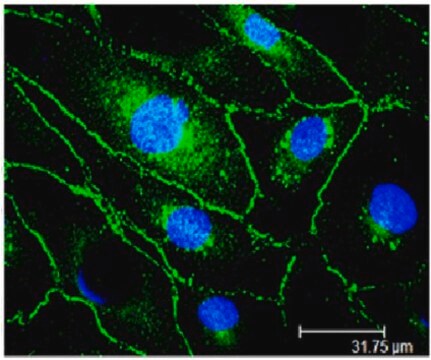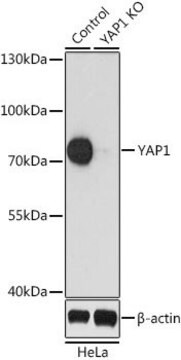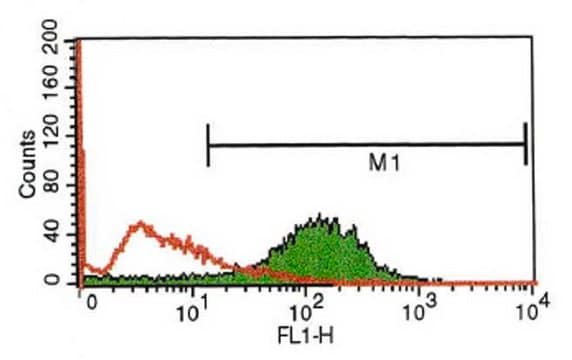おすすめの製品
由来生物
mouse
結合体
unconjugated
抗体製品の状態
purified immunoglobulin
抗体製品タイプ
primary antibodies
クローン
P1H12, monoclonal
形状
buffered aqueous solution
分子量
antigen 130 kDa
化学種の反応性
human
テクニック
flow cytometry: suitable using 2% paraformaldehyde 9:1 methanol
immunocytochemistry: suitable using 4% paraformaldehyde 0.1-0.5% triton X-100, smears or live cells
immunohistochemistry: suitable using using acetone-fixed sections of human tongue
immunoprecipitation (IP): suitable
indirect ELISA: suitable
microarray: suitable
アイソタイプ
IgG1
輸送温度
dry ice
保管温度
−20°C
ターゲットの翻訳後修飾
unmodified
詳細
Monoclonal Anti-Endothelial cells (CD146) (mouse IgG1 isotype) is derived from the P1H12 hybridoma produced by the fusion of mouse myeloma cells and splenocytes from mice immunized with human umbilical cord cells (HUVEC). CD146 (cluster of differentiation 146) is also known as the melanoma cell adhesion molecule (MCAM), cell surface glycoprotein MUC18, A32, Mel-CAM and S-Endo-1. It is encoded by the MCAM gene. It belongs to the immunoglobulin supergene family with five immunoglobulin-like domains (V-V-C2-C2-C2), a transmembrane region and a 63 residue cytoplasmic tail. It is located on human chromosome11q23.
特異性
培養微小血管内皮細胞(MVEC)および大脈管内皮細胞(HUVEC)をはじめ、組織や血中の内皮細胞を認識します。
免疫原
ヒト臍帯細胞(HUVEC)。
アプリケーション
Anti-Endothelial Cells antibody, Mouse monoclonal has been used in:
- immunocytochemistry
- immunohistochemistry
- flow cytometry
- immunoprecipitation
- enzyme-linked immunosorbent assay (ELISA)
- western blotting
生物化学的/生理学的作用
CD146 (cluster of differentiation 146) expression can stimulate tumor development in human melanoma, through enhanced interaction between melanoma cells and endothelial cells. However, in breast carcinoma, CD146 may act as a tumor suppressor. CD146 is expressed by the intermediate trophoblast in the placental site and binds to its putative receptor in uterine smooth muscle cells during implantation and placentation, thus limiting trophoblastic invasion in the myometrium.
Soluble CD146 (cluster of differentiation 146) is associated with the activation of angiogenesis. Circulating endothelial cells (CECs) may help in predicting clinical outcome in cancer patients. Tumor endothelial markers are expressed in a wide range of tumor types and in normal vessels associated with wound healing and corpus luteum formation. It may have significant implications for the development of anti-angiogenic therapies as well.
物理的形状
0.01M PBS溶液 (pH 7.4, 15mM アジ化ナトリウム含有)。
免責事項
Unless otherwise stated in our catalog or other company documentation accompanying the product(s), our products are intended for research use only and are not to be used for any other purpose, which includes but is not limited to, unauthorized commercial uses, in vitro diagnostic uses, ex vivo or in vivo therapeutic uses or any type of consumption or application to humans or animals.
Not finding the right product?
Try our 製品選択ツール.
試験成績書(COA)
製品のロット番号・バッチ番号を入力して、試験成績書(COA) を検索できます。ロット番号・バッチ番号は、製品ラベルに「Lot」または「Batch」に続いて記載されています。
Expression of CD markers in JAK2V617F positive myeloproliferative neoplasms: Prognostic significance
Shahrabi S, et al.
Oncology reviews, 12(2) (2018)
Targeting CD146 with a 64Cu-labeled antibody enables in vivo immunoPET imaging of high-grade gliomas
Yang Y, et al.
Proceedings of the National Academy of Sciences of the USA, 112(47), E6525-E6534 (2015)
M Ilie et al.
British journal of cancer, 110(5), 1236-1243 (2014-01-30)
Previous studies indicate that endothelial injury, as demonstrated by the presence of circulating endothelial cells (CECs), may predict clinical outcome in cancer patients. In addition, soluble CD146 (sCD146) may reflect activation of angiogenesis. However, no study has investigated their combined
Xianyi Yu et al.
Pediatric research, 55(4), 688-694 (2004-02-07)
Nitric oxide (NO) serves many vasoprotective roles, but the massive release of NO causes arterial wall degeneration. We investigated whether enhanced nitric oxide synthase (iNOS) expression in peripheral blood leukocytes and circulating endothelial cells mirrors the progression of coronary arterial
B St Croix et al.
Science (New York, N.Y.), 289(5482), 1197-1202 (2000-08-19)
To gain a molecular understanding of tumor angiogenesis, we compared gene expression patterns of endothelial cells derived from blood vessels of normal and malignant colorectal tissues. Of over 170 transcripts predominantly expressed in the endothelium, 79 were differentially expressed, including
ライフサイエンス、有機合成、材料科学、クロマトグラフィー、分析など、あらゆる分野の研究に経験のあるメンバーがおります。.
製品に関するお問い合わせはこちら(テクニカルサービス)








